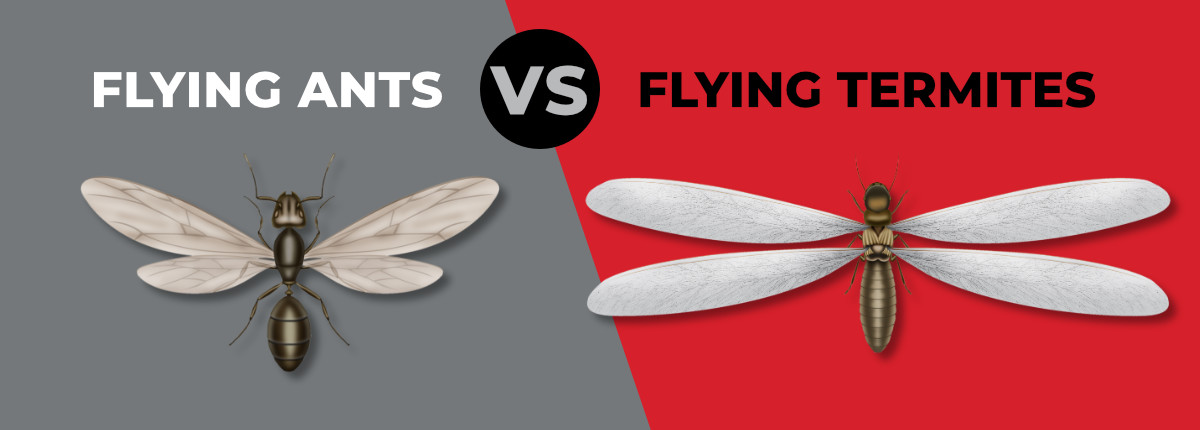Flying Ants or Flying Termites? How to Tell The Difference

Are those winged insects around your home termites or ants? It can be hard to tell the difference, but trust us when we say you don't want either of them invading your space.
As a leading termite and ant control company in the NJ/PA/DE/MD area, we know a thing or two about flying termites and ants, also known as "swarmers." In this blog, we'll dive into the key differences between these pesky insects and why you should be on high alert when you spot them.
Let's get this show on the road:
Termite Swarmers vs. Ant Swarmers: The Differences
Termite and ant swarmers, the winged reproductive members of their respective colonies, can look quite similar, but some key differences can help you identify which pest you're dealing with. As a pest control company serving NJ, PA, DE, and MD, we want to ensure our clients are informed and can take the necessary action to protect their homes from these destructive pests.
Here are some of the most common differences:
1. Appearance Differences
Termites have straight antennae and wide bodies without pinched waists, whereas ants' antennae are elbowed at the ends, and their abdomens narrow to a point.
Many species of both insects share similar physical characteristics: they're small (usually less than 3/8 inch long), soft-bodied, get around by walking on six legs with two other appendages used as feelers—and can be either black or brown in color.
2. Behavior Differences
Another way to tell the difference between flying ants and termite swarmers is by their behavior. Flying ants are typically more active during the day and are attracted to sweet or sugary substances.
On the other hand, termite swarmers are more active at night and are drawn to light sources. They also tend to shed their wings once they've found a place to start a colony.
3. Diet Differences
Diet also sets these two pests apart. Ants are omnivores and primarily feed on anything edible apart from wood.
Termites, on the other hand, feed on cellulose which is a nutrient-rich material found in plants. They consume mainly wood, paper, and other cellulose-based products.
4. Damage Differences
One of the biggest differences between flying ants and termite swarmers is the damage they can cause. While both insects can damage your home, termites are infamous for their ability to eat through wood and cause costly damage to the structure of your home. If you spot any signs of wood damage or hollowed-out wood, termites are likely the culprits.
Pro Tip: Keeping Your Home Safe
Acting fast is important if you suspect you have an ant or termite infestation. Both insects can quickly multiply and cause significant damage to your home. The best way to deal with the problem is by contacting a pest control professional.
They can assess the situation and recommend the best course of action, including baiting, trapping, or insecticide treatments.
Termites vs. Ants: Which is Worse?
When it comes to termites vs. ants, there's no contest. Termites are the bigger threat; you don't want them in your home. Keep an eye out for these pesky intruders, and take action if you suspect an infestation.
Here's the thing, termites are not picky eaters. They will happily munch on any cellulose-based material, including the wooden structure of your home. And the worst part? They can do it for years without you even realizing it.
In fact, termites cause more property damage than fires, floods, and storms combined.
That's why it's crucial to know the signs of a termite infestation and act fast. Look out for hollow-sounding wood, discarded wings, and mud tubes. If you suspect you have termites, don't wait to call in a professional. The longer you wait, the more damage they can do.
Hassle-Free And and Termite Control Solutions for Your Home
Regardless of which insect species is bugging you, know that winged termites and ants usually mean that there is a mature colony nearby that is ready to expand. It's important to stay vigilant regarding pest control. Don't let termites and ant swarmers take over your home. These pesky insects can cause serious damage and cost you thousands of dollars in repairs. You can protect your home and wallet by learning how to identify and deal with these pests.
At Viking Pest, we use the latest technology and techniques to control and prevent termite and ant infestations effectively. Our termite baiting system is safe, eco-friendly, and highly effective for controlling termite populations.
We serve NJ, PA, DE, and MD, so call today at 800-618-2847 or request a free quote on our website and protect your property from these destructive pests.











